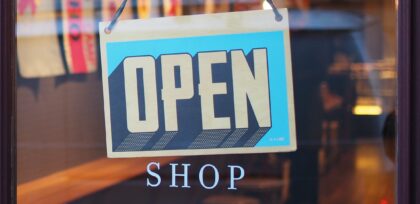Google Shopping and Using Google For Smarter Growth
22 May 2020|5 MIN READ
Google Shopping is appearing more and more frequently on page one of the organic SERPs. This has had a huge impact on SEO, and to date there is as much as 10% organic traffic loss for some eCommerce sites.
According to Search Engine Land, up to 10% of eCommerce players' organic traffic is lost as a result of Google Shopping Ads.
Last month, myself and Andrew McGarry, owner and founder of The McGarry Fashion Agency, explored how to fight Google with Google to offset this loss, and build a successful eCommerce SEO. Below are our combined takeaways from the webinar, which you can watch here:
https://youtu.be/6RV_mmOq57o
On April 21st, 2020, Google made the decision to revert its Shopping results from paid to primarily free listings.
Despite this development, Google Shopping results on page one will continue to be ‘Paid for’ real estate, and have in fact grown in number, as noted by Third Door Media’s Editor-in-Chief, Ginny Marvin:
“The main Google Search page is not changing, and the carousels of product listing ads (PLAs) will continue to consist of ads only… Merchants that want to ensure prominent visibility in the search results, now more competitive with more products eligible to show, will continue to pay for ads.”
Ginny Marvin, Search Engine Land
[icon-cta-banner colour='blue' headline="Subscribe to Jon Earnshaw's Newsletter" icon='/wp-content/uploads/2018/10/Jon-Earnshaw-Talk_icon.svg' cta_action='/jon-earnshaw-shed-news/' cta_text='Subscribe now']
With more ‘Product listed ads’ incorporated into page one, will we see even bigger dents to eCom traffic in future?
Not if we're smart.
Despite the fact that Google Shopping ads sit pride of place at the top of the SERPs, research by Nielson Norman shows that a user's eyes focus on all visual search results before reaching classic blue listings – even those that sit further down the page!

Are Google’s Featured Snippets therefore key to building a successful strategy for eCommerce SEO ?
And how else can we use Google to beat Google at its own game?
How can you recover traffic lost from Google Shopping ads?
Maximise brand traffic
Google Shopping results are unlikely to revert back to organic, as ads are Google’s main source of YoY revenue growth. Organic teams need to accept this fact, maximise brand traffic as normal, and know that overall organic traffic could be starting from a -10% position.
Think like a publisher
If you haven’t adopted the ‘Think like a publisher’ mindset yet, and are still trying to rank your eCommerce catalogue pages, then unless you have a large outreach budget for PR / SEO exposure (with links!), you are going to struggle to find growth opportunities.
You may find that you are paying more to affiliate sites who do publish content that attracts your audience. But paying for traffic you could have attracted directly to your site isn’t the smartest strategy.
Brands can offset traffic loss from Google Shopping by understanding the user journey, the role organic touchpoints play within it, and creating content to keep people engaged in their product or service.
Identify new content opportunities using Google itself
Whilst we may lose some real estate to Google Shopping, a key thing we can do is to look closely at the SERP and identify new content opportunities.
We have the potential to position for more than just a single classic link on page one; SERP features provide unmatched visual content opportunity to rival that of Google Shopping’s PLAs.
And, even more importantly, the answers we need to win that opportunity, shape our ecosystem and open more doorways into our online world, lie in the SERP itself.
As an example, we can optimise our content to feature in:
People also ask

The ‘People also ask’ universal search feature is key to increasing our search real estate!
Google Shopping can’t answer questions!
Who wins the click in the customer’s ‘Research’ phase? It's the content creator who gets inside the mind of the searcher, understands what they're thinking, looking for, asking and creates the content that covers that.
‘People also ask’ is not only a great visual feature, it enables us to answer our customers’ most important questions and surface more of our website content.
But beyond that, the questions appearing in this feature enable us to create our content.
It gives us insight into the mind of our customers, including what they're looking for and the kinds of language they're using.
Google's rich answers

Whatever we think of the Google Answer Box - i.e. whether or not it boosts our traffic - we should aim to own it over our competitors.
Even though we may lose a secondary link in the classic listings when we own the answer box, there's no reason why we can't also rank organically elsewhere on page one with a semantically related article; thereby opening up yet another doorway to our website.
[icon-cta-banner colour='blue' headline="Subscribe to Jon Earnshaw's Newsletter" icon='/wp-content/uploads/2018/10/Jon-Earnshaw-Talk_icon.svg' cta_action='/jon-earnshaw-shed-news/' cta_text='Subscribe now']
Use Google to build your content, SEO and even your brand
The organic channel is a brand messenger.
That means the best tech setup in the world that maximises visibility will only deliver value IF they can win the click, and then have an interesting idea or story to share.
The product or service that doesn’t come with a hook or something shiny to engage with, will quickly lose our interest.
Organic visitors that don’t engage with the site are the wrong kind of traffic. This is why audience targeting through storytelling and great copy matters.
Language wins the click and the connection
We need ideas and concepts that stick in our minds. If NIKE can build an empire around three words - JUST DO IT - then the space provided in meta data is enough to grab attention and hook people in.
And to build that brand from its inception, we have the power to see what our audience wants by looking at how the search landscape is already constructed. The types of content our customers want to interact with, the related topics they care about - it’s all there in the SERP.
The collaboration between technical and creative content thinkers in the organic channel is key.
When we do this, we are able to take on goliaths like Google.
So how can you use Google for smarter growth?
Prioritise search features
Building a strategy for eCommerce SEO that prioritises Google’s own real estate opportunity can help us challenge the dominance of Google, boost traffic and awareness, and even shape our product / brand.
Answer questions
Organic teams need to see Google as an ‘Answer engine’, researching and creating content that answers all of the questions that someone might have around that product or service. Stores that have a first-time visitor landing page typically see better conversion rates, yet few brands adopt this approach.
Track the user journey
Organic’s true value is how it creates and delivers user journey touchpoints that are not ‘Last click’. Before you buy a car, you might carry out over 100 touchpoints or points of research. In fashion, the average is less than 8, so it’s much easier to map out using Google Analytics. If you can’t do attribution in GA, you can’t communicate the true value of organic, so that has to be a core part of any SEO project.
Track search volumes
Track volumes, not only in Google, but also in YouTube, Amazon, and anywhere else where you can better evaluate the market opportunity. Measuring brand awareness has to go beyond Google, or else you will not see the full picture. Especially in the rise of marketplaces, pre-loved marketplaces, and apps.
[icon-cta-banner colour='blue' headline="Subscribe to Jon Earnshaw's Newsletter" icon='/wp-content/uploads/2018/10/Jon-Earnshaw-Talk_icon.svg' cta_action='/jon-earnshaw-shed-news/' cta_text='Subscribe now']
Never miss a post
Join our mailing list and have our SEO news delivered straight to your inbox.
Never miss a post
Join our mailing list and have our SEO news delivered straight to your inbox.





